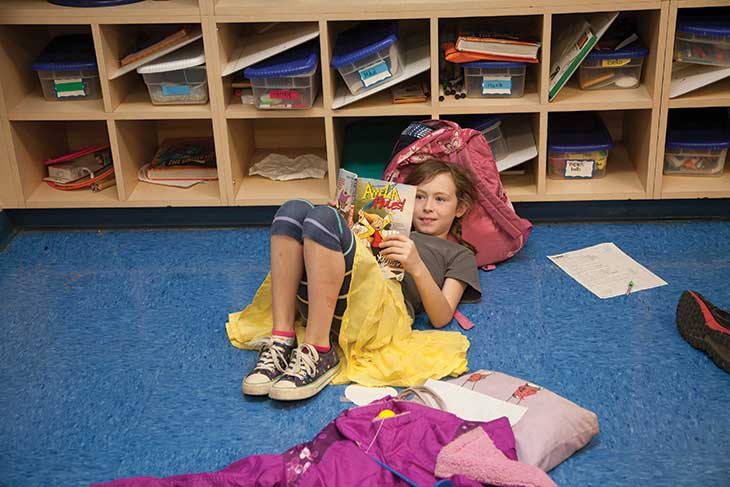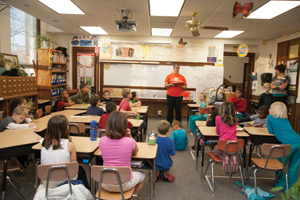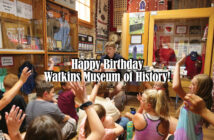| Fourth Quarter 2012 | story by DAISY WAKEFIELD | photos by STEVEN HERTZOG |

The 2012 National Youth of the Year for Boys and Girls Club of America is not shy in speaking about the adversity she had to overcome while growing up, and she credits the Boys and Girls Club program and people with providing the stability and vision for her to achieve more than her circumstances would dictate. Now a freshman at the University of Arkansas, Dudley has goals of one day running her own nonprofit organization dedicated to helping young people.
“It’s a testament to how amazing our staff are, the impact we’re having on kids as we focus on activities and academic success, and how much this program helps kids who are struggling in one way or another,” says Erika Zimmerman, Director of Development.
Kids who may be struggling make up a signifi cant portion of the population at the aft er-school program. Nearly 60% of Boys and Girls Club families receive free or reduced lunch from the school district and a scholarship for fees from the Boys and Girls Club. Fees are determined by a sliding scale of income, and no child is turned away for inability to pay.
 “We have kids who are in foster homes, living with grandparents, or single parent homes, and it’s an opportunity for us to influence kids who are at risk of dropping out or using drugs and alcohol,” says Colby Wilson, Executive Director. “The kids in these situations are at higher risk for ending up in the safety nets of our society, and while we need to support people in those situations, our goal is to keep them from getting there. Our program is an aff ordable, high quality option that promotes academics, character, and making healthy choices.”
“We have kids who are in foster homes, living with grandparents, or single parent homes, and it’s an opportunity for us to influence kids who are at risk of dropping out or using drugs and alcohol,” says Colby Wilson, Executive Director. “The kids in these situations are at higher risk for ending up in the safety nets of our society, and while we need to support people in those situations, our goal is to keep them from getting there. Our program is an aff ordable, high quality option that promotes academics, character, and making healthy choices.”
The Boys and Girls Club has grown in the last ten to twelve years from 150 members to its current 1800. The original building on Haskell was the only building in use until an on-site Club began at Cordley Elementary. Programs have spread to 12 elementary schools and the former East Heights Elementary School hosts students who do not have an on-site program at their school.
Six full-time administrators and 12 full-time program managers handle the operations of the program, alongside 140 part-time program staff . KU students constitute 95% of staff , many of who are looking for experience to supplement degrees in education or other youth-oriented fields.
The school district rents the East Heights building to the Boys and Girls Club for $1 a year and hosts the on-site programs without charge to the Club. Federal grants from the Department of Education have provided the other funding necessary to run the school sites.
“We believe philosophically that we can have deeper impact with kids when we are on site at the elementary schools,” Wilson says. “The coordination that exists between the Boys and Girls Club and the school district sounds like a no-brainer, but it’s not a reality in many other communities. Many struggle with getting support from their local school district and getting the collaboration and connection for it to work. Our board, the previous director, and staff here have done a great job making it work, and the school district has reciprocated. That’s the key to our success here. Lawrence should be held up as a symbol for how it could work.”
 For it to continue to work, though, Wilson says the Club needs to build more diverse and sustainable revenue streams. The Club’s $2.3 million budget currently comes from two main sources – fees and the 21st Century Grant from the department of Education. Other sources include the United Way, City of Lawrence, and a few fundraising events. However, some of the grant monies are due to roll off in the next few years, and it is uncertain whether the Club will be able to reapply. Leadership within the organization is talking about how to find and bolster other income streams like individual and foundation support to decrease salary expenses.
For it to continue to work, though, Wilson says the Club needs to build more diverse and sustainable revenue streams. The Club’s $2.3 million budget currently comes from two main sources – fees and the 21st Century Grant from the department of Education. Other sources include the United Way, City of Lawrence, and a few fundraising events. However, some of the grant monies are due to roll off in the next few years, and it is uncertain whether the Club will be able to reapply. Leadership within the organization is talking about how to find and bolster other income streams like individual and foundation support to decrease salary expenses.
While most of the kids attending are elementary school students, a program for middle and high school kids is held at the original Boys and Girls Club building on Haskell. Wilson says that these programs hold major potential for development, as the Club seeks to engage students through these upper grades and provide support for students to get into college, trade school, and other post-secondary education goals. Beyond the direct economic impact of the Boys and Girls Club as an employer with a payroll of about $1.5 million, the Club also brings indirect economic benefits.
“Parents who are working and have their children in Th e Boys and Girls Club are more productive workers when they don’t have to worry about where their kids are and what are they doing,” says Al Hack, Board Member. “Additionally, the skills that the club members learn while attending the club make them better employees in the future when they enter the work force. From an economic point of view, everyone wins with the help of The Boys and Girls Club.”




20 Comments
secure checkout ED drugs: online Cialis pharmacy – secure checkout ED drugs
affordable ED medication: affordable ED medication – discreet shipping ED pills
discreet shipping ED pills: Cialis without prescription – secure checkout ED drugs
discreet shipping ED pills secure checkout ED drugs reliable online pharmacy Cialis
cheap Cialis online: Cialis without prescription – order Cialis online no prescription
legal Modafinil purchase: verified Modafinil vendors – Modafinil for sale
generic tadalafil: cheap Cialis online – generic tadalafil
modafinil 2025 buy modafinil online verified Modafinil vendors
where can i buy prednisone online without a prescription: prednisone 20 mg tablet – PredniHealth
prednisone 50 mg for sale iv prednisone PredniHealth
PredniHealth: buy prednisone tablets uk – PredniHealth
can you get clomid without insurance: where can i get cheap clomid no prescription – can i buy generic clomid pills
can i buy generic clomid without rx Clom Health can i get clomid online
generic amoxil 500 mg: amoxicillin without a prescription – Amo Health Care
PredniHealth: prednisone 2.5 mg price – PredniHealth
Amo Health Care Amo Health Care Amo Health Care
amoxicillin 30 capsules price: Amo Health Care – amoxicillin 500 mg brand name
average cost of prednisone: PredniHealth – PredniHealth
PredniHealth PredniHealth PredniHealth
where can you get amoxicillin: Amo Health Care – azithromycin amoxicillin